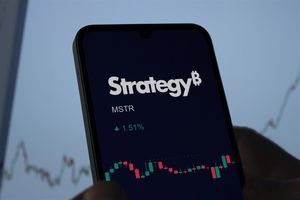
New York, NY – November 11, 2025 – The Dow Jones Industrial Average (DJIA) has today surged to an unprecedented all-time high, pushing past significant milestones and reinforcing a complex, yet largely optimistic, sentiment across the financial markets. This monumental achievement signals a robust, albeit cautious, wave of investor confidence, underpinned by a unique blend of economic expectations and corporate performance. The blue-chip index's ascent reflects a broader narrative of economic resilience, even as underlying currents hint at a discerning shift in investment strategies.
The immediate implications of this record-breaking performance are multifaceted. While the headline figure paints a picture of widespread prosperity, a closer look reveals a nuanced market landscape. Investor confidence, particularly in established blue-chip companies, has received a significant boost, fueled by positive corporate earnings and the anticipation of continued monetary policy easing. However, this optimism is tempered by a notable divergence, with the tech-heavy Nasdaq Composite experiencing a slight dip, suggesting a rotation out of high-growth technology stocks and into more value-oriented sectors. This shift indicates that while the overall market is strong, investors are becoming increasingly selective, seeking stability and perceived undervaluation in a dynamic economic environment.
Unpacking the Ascent: A Detailed Look at the Market's Milestone
Today's record close for the Dow Jones Industrial Average marks a significant moment in the financial calendar of 2025. While specific point figures are still being tallied, the index's climb above previous thresholds, reportedly approaching the 48,000 mark, signifies its 16th record close for the year, a testament to sustained bullish momentum. This remarkable achievement is not a sudden phenomenon but the culmination of several key factors that have been shaping market sentiment and investor behavior throughout the year.
The timeline leading up to this moment has been characterized by a series of pivotal developments. Expectations of continued interest rate cuts by the Federal Reserve have been a significant catalyst, with market participants eagerly awaiting further easing of monetary policy to stimulate economic growth. This anticipation has been closely tied to the availability of critical labor and inflation data, which, despite a temporary U.S. government shutdown earlier in the year, was expected to resume its flow, guiding the Fed's decisions. Strong corporate earnings reports from many Dow components have consistently reinforced investor enthusiasm, showcasing solid revenue growth and improved profit margins across various sectors. Companies like Merck & Co. (NYSE: MRK), Amgen Inc. (NASDAQ: AMGN), and Nike Inc. (NYSE: NKE) have been cited among those leading the charge, demonstrating the appeal of established firms with robust fundamentals. Salesforce (NYSE: CRM) also contributed to renewed confidence with positive long-term projections and an expanded share buyback program.
Key players in this market ascent include the Federal Reserve, whose monetary policy decisions continue to wield immense influence over market direction, and the corporations themselves, whose earnings and forward guidance dictate investor appetite. The political landscape, particularly the resolution of the temporary government shutdown, also played a crucial role in bolstering confidence by ensuring the continuity of economic data essential for informed decision-making. Initial market reactions, beyond the general optimism, have highlighted a distinct rotation from growth-oriented technology stocks, which had previously benefited from the "AI bull trade," towards value stocks and broader sectors of the U.S. economy, such as healthcare, energy, and consumer staples. This shift suggests a cautious approach by investors, who are increasingly scrutinizing valuations and seeking more stable, less overvalued assets.
Winners and Losers: Corporate Impact of the Dow's New High
The Dow's historic surge ushers in a period of both opportunity and challenge for public companies trading in the market, creating a distinct landscape of potential winners and losers. The sectors and individual firms poised to benefit most are typically those represented within the Dow Jones Industrial Average itself, often referred to as blue-chip companies, alongside value stocks that have been less susceptible to the high valuations seen in other market segments. Conversely, some high-growth technology companies, particularly those with stretched valuations, may face headwinds as investors reallocate capital.
Companies within the healthcare, energy, and consumer staples sectors are likely to be among the primary beneficiaries. Firms like Merck & Co. (NYSE: MRK) and Amgen Inc. (NASDAQ: AMGN), which have demonstrated strong earnings and consistent performance, are prime examples of the types of companies attracting investor capital in this environment. Their stability and dividend yields become particularly attractive when the market seeks less volatile assets. Similarly, companies involved in essential goods and services, often less sensitive to economic cycles, tend to perform well during periods of market rotation. The renewed focus on value means that companies with strong balance sheets, consistent profitability, and reasonable price-to-earnings ratios are likely to see continued interest.
On the other hand, the "AI bull trade" that propelled many technology stocks to dizzying heights earlier in the year may be experiencing a cooling-off period. While innovation remains a key driver, concerns over elevated valuations and the high operational costs associated with AI "hyperscalers" are prompting investors to exercise caution. This doesn't necessarily mean a widespread decline for tech giants, but rather a more discerning approach, where companies without clear profitability pathways or sustainable competitive advantages might struggle to maintain their premium valuations. The divergence between the Dow's surge and the Nasdaq's modest slip underscores this re-evaluation. Companies that have relied heavily on speculative growth narratives without commensurate financial performance could find themselves on the losing side of this market rotation, as capital flows towards more established and financially robust entities.
Broader Significance: Trends, Ripple Effects, and Historical Context
The Dow Jones Industrial Average reaching a new all-time high on November 11, 2025, is more than just a headline; it's a significant marker within broader industry trends and economic narratives. This event signals a continued, albeit evolving, bull market, suggesting underlying strength in the U.S. economy. The rotation from growth to value stocks, as evidenced by the Dow's outperformance relative to the Nasdaq, indicates a maturing market cycle where investors are prioritizing profitability and stability over speculative growth. This trend reflects a cautious optimism, where fundamental strength is increasingly valued amidst lingering concerns about inflation and the pace of economic expansion.
The ripple effects of this milestone are likely to be felt across various sectors and among competitors and partners. For companies whose stocks are included in the Dow, increased visibility and investor confidence can lead to further capital inflows and potentially lower costs of capital. Competitors in less favored sectors, particularly high-growth tech, might face increased pressure to demonstrate clearer paths to profitability and sustainable business models to attract and retain investor interest. Partners in the supply chain or joint ventures with strong-performing Dow components may also see indirect benefits through increased business activity and stability. Furthermore, the overall positive market sentiment could encourage mergers and acquisitions, as companies with strong balance sheets look to expand or consolidate their positions.
From a regulatory and policy perspective, a sustained market rally could influence future decisions by the Federal Reserve. While expectations of interest rate cuts have fueled much of the recent optimism, a continuously strong market might give the Fed more flexibility in its monetary policy decisions, potentially allowing for a more gradual approach to easing if inflation remains a concern. Historically, periods of sustained market highs have often been followed by careful scrutiny from regulators regarding market stability and potential bubbles. Comparisons to similar events in the past, such as the dot-com boom or the pre-2008 financial crisis peaks, serve as reminders for investors and policymakers to remain vigilant, even amidst celebratory highs. While the current environment differs significantly in its underlying economic drivers, the lessons of market cycles and the importance of fundamental analysis remain paramount.
What Comes Next: Navigating the Future Market Landscape
The Dow's new all-time high sets the stage for a compelling period of market activity, presenting both short-term tactical considerations and long-term strategic implications for investors and corporations alike. In the immediate future, the market is likely to grapple with the ongoing interplay between inflation data and the Federal Reserve's interest rate policy. Any deviations from the expected path of rate cuts, either due to persistent inflation or unexpected economic slowdowns, could introduce volatility. However, sustained positive corporate earnings and a stable geopolitical environment could further solidify the market's upward trajectory.
Looking further ahead, the long-term possibilities suggest a continued emphasis on fundamental strength and value. Companies that can consistently deliver strong earnings, manage costs effectively, and adapt to evolving consumer demands will likely thrive. The rotation from growth to value stocks could mature into a more balanced market, where both established blue-chips and innovative, yet financially sound, growth companies find favor. Potential strategic pivots for corporations might include a renewed focus on operational efficiency, prudent capital allocation, and a cautious approach to expansion, especially in sectors where valuations remain elevated.
Market opportunities are likely to emerge in sectors benefiting from long-term demographic shifts, infrastructure development, and sustainable technologies, assuming these areas are supported by sound economic fundamentals rather than speculative hype. Challenges will persist for companies struggling with high debt loads, intense competition, or an inability to innovate effectively. Potential scenarios range from a continued, steady bull run, albeit with periodic corrections, to a more significant re-evaluation if economic data or corporate performance disappoints. Investors should watch for further cues from the Federal Reserve, global economic indicators, and, crucially, the upcoming quarterly earnings reports, which will provide vital insights into corporate health and future outlooks.
Comprehensive Wrap-up: Assessing the Market's Enduring Impact
Today's record-breaking performance by the Dow Jones Industrial Average is a landmark event, signaling a period of robust investor confidence and underlying economic strength. The key takeaway is the market's resilience and its capacity to adapt, as evidenced by the strategic rotation of capital from high-growth tech to more value-oriented, established blue-chip companies. This shift underscores a maturing market where fundamentals, profitability, and stable growth are increasingly prized, even as technological innovation continues to drive long-term potential.
Moving forward, the market is positioned for continued dynamism. While the celebratory mood is palpable, a cautious optimism prevails, reminding investors that even in times of record highs, vigilance is paramount. The interplay of monetary policy, corporate earnings, and global economic stability will continue to dictate market movements. Investors should not view this new high as an invitation for unbridled speculation, but rather as a confirmation of a strong, yet discerning, market environment.
The lasting impact of this event lies in its potential to reinforce a more balanced investment philosophy, encouraging a deeper dive into company fundamentals rather than solely chasing momentum. It also highlights the enduring appeal of well-managed, established companies that form the backbone of the U.S. economy. What investors should watch for in the coming months includes the Federal Reserve's next moves on interest rates, the trajectory of inflation, and critically, how companies across all sectors navigate the evolving economic landscape to deliver sustainable growth and shareholder value.
This content is intended for informational purposes only and is not financial advice





